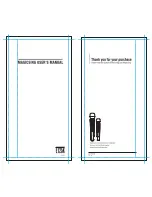
7
CONTROL SETUP
General —
The 35E single-duct VAV (variable air volume)
terminal is designed to supply a varying quantity of cold prima-
ry air to a space in response to a thermostat demand. Some
units have reheat options to provide heating demand require-
ments as well. Most VAV terminals are equipped with pressure
compensating controls to regulate the response to the thermo-
stat independent of the pressure in the supply ductwork.
To balance the unit, it is necessary to set both the maximum
and minimum set points of the controller. The many types of
control options available each have specific procedures re-
quired for balancing the unit.
Set Points —
Maximum and minimum airflow set points
are normally specified for the job and specific for each unit on
the job. Where maximum and minimum airflow levels are not
specified on the order, default values are noted on unit ID label.
Field Adjustment of Minimum and Maximum
Airflow Set Points —
Each 35E unit is equipped with a
flow probe that measures a differential pressure proportional to
the airflow. The relationship between flow probe pressures and
cfm is shown in the Linear Probe CFM vs Pressure Signal
Graph (Fig. 6). This chart is attached to each unit.
System Calibration of the Linear Averaging
Flow Probe —
To achieve accurate pressure independent
operation, the velocity sensor and linear averaging flow probe
must be calibrated to the controller. This will ensure that air-
flow measurements will be accurate for all terminals at system
start-up.
System calibration is accomplished by calculating a flow
coefficient that adjusts the pressure fpm characteristics. The
flow coefficient is determined by dividing the flow for a given
unit (design air volume in cfm), at a pressure of 1.0 in. wg dif-
ferential pressure, by the standard pitot tube coefficient of
4005. This ratio is the same for all sizes if the standard linear
averaging probe is used.
Determine the design air velocity by dividing the design air
volume (the flow at 1.0 in. wg) by the nominal inlet area
(sq ft). This factor is the K factor.
Carrier inlet areas are shown in the table below. The design
air volume is also shown in this table. It can be determined
from this table that the average design air velocity for 35E units
is equal to 2656 fpm at 1.0 in. wg.
.
NOTE: For Carrier ComfortID™ terminals, all flow sizes are normal-
ized using a single Probe Multiplier (PMF) for all sizes equal to
2.273.
Record the information on a performance sheet (see
Fig. 7). This will provide a permanent record of the balanc-
ing information.
•
installation location information
•
box size
•
cooling minimum airflow (cfm) limit
•
cooling maximum airflow (cfm) limit
•
reheat (cfm) limit (if applicable)
•
heating minimum airflow (cfm) limit (if applicable)
•
heating maximum airflow (cfm) limit (if applicable)
•
calibration gain (after balancing)
•
set points
PNEUMATIC CONTROLS
Preparation for Balancing (Control Sequences
1102 and 1103)
1. Inspect all pneumatic connections to assure tight fit and
proper location.
2. Verify that the thermostat being used is compatible with
the control sequence provided (direct acting or reverse
acting).
3. Check main air pressure at the controller(s). The main air
pressure must be between 15 psi and 25 psi. (If dual or
switched-main air pressure is used, check the pressure at
both high and low settings.) The difference between
“high” pressure main and “low” pressure main should be
at least 4 psi, unless otherwise noted, and the “low” set-
ting difference should exceed 15 psi.
4. Check that the unit damper will fail to the proper position
when main air pressure is lost. Disconnect the pneumatic
actuator line from the velocity controller and observe the
VAV damper position. The damper should fail to either a
normally open position (indicator mark on shaft end is
horizontal) or a normally closed position (indicator mark
on shaft end is vertical).
5. Check that there is primary airflow in the inlet duct.
6. Connect a Magnehelic gage, inclined manometer or other
differential pressure measuring device to the balancing
taps provided in the velocity probe sensor lines. The
manometer should have a full scale reading of 0.0 to
1.0 in. wg. The high pressure signal is delivered from the
front sensor tap (away from the valve), and the low pres-
sure signal is delivered from the back line (near the
valve). The pressure differential between high and low
represents the amplified velocity pressure in the inlet
duct.
7. Read the differential pressure and enter the Linear Aver-
aging Probe Chart to determine the airflow in the terminal
unit. This chart is shown in Fig. 6 and is also attached to
the side of each unit. For example, a differential pressure
of 0.10 in. wg for a size 8 unit yields an airflow of
275 cfm.
Volume controllers for 35EP units are shown in Fig. 8-10.
Identification for each controller is shown in Table 4.
UNIT SIZE 35E
04
05
06
07
08
09
INLET
DIAMETER
4.0
5.0
6.0
7.0
8.0
9.0
AIRFLOW (Cfm)
AT 1 in. wg
232
362
502
710
927
1174
INLET AREA
(sq ft)
0.087
0.136
0.196
0.267
0.349
0.442
35E UNIT SIZE
10
12
14
16
22
INLET DIAMETER
10.0
12.0
14.0
16.0
16 x 24
AIRFLOW (Cfm)
AT 1 in. wg
1449
2086
2840
3709
7250
INLET AREA
(sq ft)
0.545
0.785
1.069
1.396
2.640








































